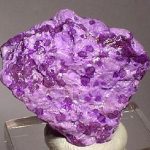Sugilite
Sugilite was originally discovered in 1944 by Japanese geologist Ken-ichi Sugi on Iwagi Island, Japan as very tiny yellowish crystals. It wasn’t until 1975, when a thin seam of purplish Sugilite was found in a core sample in the Kuruman manganese fields of South Africa. In 1979 a huge mass, as much as 10-12 tons, of Sugilite was discovered at a depth of 3,200 feet at this location. Only half of this material had the fine grape jelly color that is highly desired. Of this, a tiny percentage (maybe 0.1%) is translucent. Some transparent Sugilite has been cut into gems, but these are very rare. Sugilite has become very popular in the jewelry trade as cabochons and carvings. It has been described as a purple Turquoise although there is no relation between the two minerals.
Sugilite is found in just a few locations worldwide including Liguria, and Tuscany Italy; Iwagi Island, Japan (Type Location); Wessels Mine, Hotazel, Kalahari manganese fields, Northern Cape Province, South Africa.
| Category: | Cyclosilicate |
| Formula: | KNa2(Fe,Mn,Al)2Li3Si12O30 |
| Crystallography: | Hexagonal – Dihexagonal Dipyramidal |
| Crystal Habit: | Crystals prismatic, to 2 cm, rare. Commonly in interlocking aggregates of subhedral grains, compact to massive. |
| Twinning: | None |
| Cleavage: | [0001] Indistinct/Poor |
| Fracture: | Irregular/Uneven |
| Tenacity: | Brittle |
| Hardness (Mohs): | 6.0 – 6.5 |
| Density: | 2.74 – 2.79 (g/cm3) |
| Luminescence: | None |
| Radioactivity: | Barely Detectable; GRapi = 54.07 (Gamma Ray American Petroleum Institute Units) |
| Color: | Light Brownish Yellow, Lavender, intense Reddish Violet, bright Magenta, Purplish, dark Rose Red |
| Transparency: | Translucent to Transparent |
| Luster: | Vitreous |
| Refractive Index: | 1.595 – 1.611 Uniaxial ( – ) |
| Birefringence: | 0.0030 |
| Dispersion: | n/a |
| Pleochroism: | Weak |


